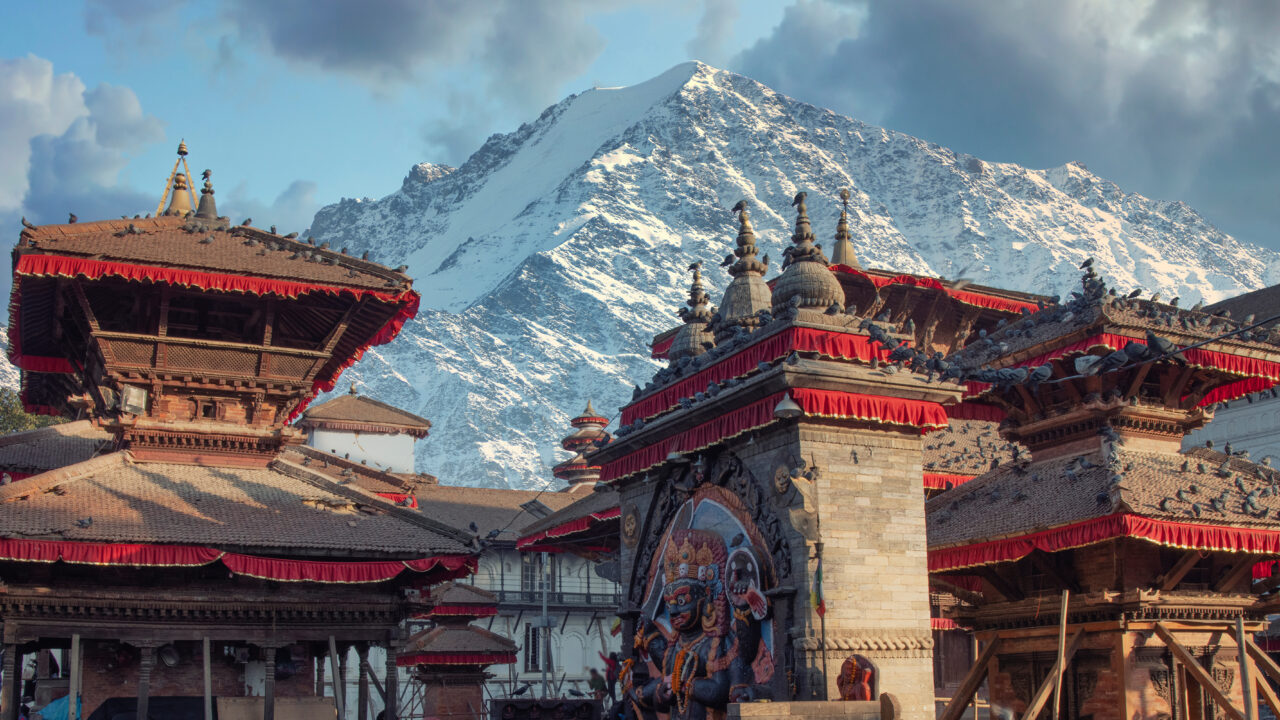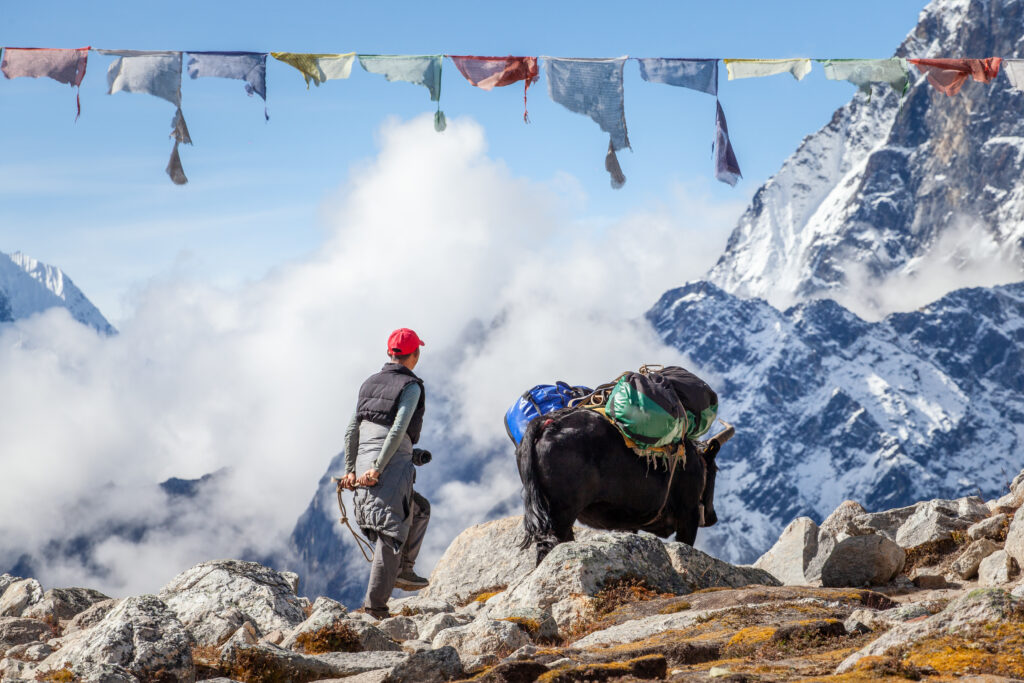The Climate Clock Is Ticking in the Himalayas
Melting Himalayan glaciers may just hold the key to climate action. Image: Adobe
Image: Adobe
I always detested glaciers. I thought whoever was running global warming’s PR team botched it in casting the ice sheets as their poster boy. The decision meant for decades Climate Change came with the inevitable image of ice caving off more ice into slightly slushier ice. When the planet needed human empathy more than ever, they chose the one place on the planet with no humans.
Nonetheless, here we are, sitting deep in the Himalayas in the remnants of the Pindari Glacier’s past. The glacier sits in the shadow of Nanda Devi which, before Sir George Everest commissioned his surveying of a certain mountain, was to many in India the tallest peak in the world. In glacier time, even the roof of the world is up for discussion. Sneaking its way out of the remaining rubble, we watch as the water starts its long journey down to the Ganges River to where it’s nourished India into one of humanity’s greatest ever civilizations.
At the root of solving climate change lies our inability to see past our default perception of time. In answering; “How much time do I have?” and “How much time do we have?”, you define your agency in solving the climate crisis.
Glaciers are the only clear visual we have to show us the time in which climate change works. An accurate clock with compounding ticks.
When close to the issue, we are constantly slingshotting back and forth between what’s seemingly just around the corner and what is unacceptably far away. We’re sandwiched between timelines of the IPCC projections for 2030 and corporate pledges for 2050. The heatwave happening today and a new zero carbon air conditioner a decade away. Most days my head is placed in the middle of a Newton’s cradle, helpless to the next ball coming back around.
In Nepal, 2050 has its own meaning. A new report from the International Centre for Integrated Mountain Development says by around 2050, the region will hit a turning point and reach “peak water.” As glaciers like the Pindari disappear, the nearly two billion people the Himalayan glaciers support will see an increase in water, before beginning a long decline into drought. Bharat Bhushan, a local glaciologist who grew up climbing around the Pindari Glacier, sees the water as more than just melting;
“If there aren’t any glaciers, those rivers won’t be there. That’s why it feels so close to me. Most of the water comes from the ice. They also hold so much good minerals that get deposited down into the plants to support our farming”
Climate change is happening in a kind of time that we’re not used to. Its rate of change is non-linear and its impacts seemingly just outside of our meticulous 5 year family plan. Even if the effects stick to a strict schedule, its feedback loops and multifaceted nature means we can never grasp the entirety of it at once, only comprehending the timeline one piece at a time.
Glaciers are the only clear visual we have to show us the time in which climate change works. An accurate clock with compounding ticks.
“When I walk through these places, I have seen these glaciers. I can see the change. I can witness it. Sudden changes are not good and an indication of a bigger thing happening in the future”, Bharats reflects. From our own perspective, time can only ever be linear. With growing research behind new climatic tipping points, phenomena such as Arctic permafrost melting, Amazon savannahfication or the slowing the circulation of our oceans, even entire ecosystems could begin to act non-linearly, going from seemingly standing still, to transforming all at once.
For the Himalayan Glaciers holding 70% of the worlds freshwater, the accelerant sits neatly on top. Black carbon and dust particles, from as far away as Saudi Arabia, collect on top and darken the ice. If clean snow, the brightest naturally occurring surface on earth, is built to be ageless by reflecting 90% of its heat, it’s as if we’ve sprinkled asphalt across our glaciers. Darkened, they then turn the attracted light into more warming.
The melted ice then trickles down in vertical streams to the rock below where rivers grow in size. The increased water adds a new layer of heat underneath the ice, bringing its warmth from the surface and increasing the friction against the ice.
At the tip of the moraine sat Baba Gee, the last wiseman of the Pindari valley. He’s meditated everyday the past 40 years below the stretch marks the Pindari Glacier has left on the valley. Instead of speaking about drought or his trash initiative, he kept steering us back to our generation’s lack of time.
“People never stay, they don’t have the time. [everything is] so fast paced now. A lot of time I make the tea then no, [they’ve already] gone down. They have no time, and now I have no time.”
How do we give ourselves more time when we have none to offer? We’re being rewired to crave what’s right in front of us and to have it now. In the age of quick reads, overnight shipping and shallow scrolling, we want shorter timelines.
“They come and go and then immediately go down. A lot of change, they take their photos for instagram or facebook then go down.” We’ve become obsessed with knowing instead of thinking, where it’s the process of finding the answer where we gain empathy and clarity.
How would we train ourselves to live in the time that’s yet to pass, to give more of our time to the future? Ancient Greek distinguishes time between chronos and kairos. Chronos is the time of clocks, calendars and history. The time the mountains know. Kaoros is the time where it feels like history has stopped and you’re here on it’s very edge. You realize you’re standing in the middle of that inescapable rushing river of time, the water passing all around.
Then there’s the moments when it feels as the clock stops, whether next to an ailing grandparent or lost in a new love. Or when you’ve escaped its grasp all together through an intense flow state, watching a butterfly in a garden or strolling through a quiet frost filled forest.

Studies show why being surrounded by towering mountains or vast oceans helps us counteract our new default and expand our sense of time. Recent research in cognitive science uncovers how across cultures, we think about time in terms of space in order to understand it. For instance saying, “that’s a big hike” or “that’ll take a long time” uses measurements of size. This link helps us uncover why being surrounded by towering mountains or vast oceans helps us zoom out . In other words, being around physically large environments enlarges our sense of time
One study aptly titled, Time Grows on Trees, suggested “that exposure to nature can slow down time perception.” Trees show time in a way buildings don’t. Another set of experiments highlighted the “sense of awe” we gain through being in nature made people “less impatient…more willing to volunteer their time to help others”. Baba Gee says that if you sit long enough, you begin to see their wisdom.
“What I have learned, I’ve learned from here…everyday [I get] new ideas or new things [from the valley].”
There’s a rich discussion around how to quantify the future, from kids suing governments for harming future generations to pricing future emissions. But focusing on how climate change will affect your local community can be most impactful. Depending on where you are in Nepal will dictate if you have too much water (the glacier still melting and causing flooding) or a lack of water, (the glaciers hit peak water). Understanding the specific needs of a community, instead of just national carbon reduction numbers, allows you to act more effectively. Bharat highlights the danger of being stuck in a global lens;
“Sometimes that doesn’t help, you don’t have direct control with any of that. What you can change is around you, not around the world.”
“You can listen to the mountains, but you need to have that attention… They are always talking to you but people turn blind and see their fury”.
Glaciers offer a brief light to remind us where we’ve walked. As the effects of climate seep into each element of life, it will be harder and harder to get a clear image of just what kind of time we’re working with. Peering back at the prehistoric cracks in the ice I see a clear picture, a quiet clock slowly ticking in reverse as if to keep track of just what kind of time we have left.
Your support matters…Independent journalism is under threat and overshadowed by heavily funded mainstream media.
You can help level the playing field. Become a member.
Your tax-deductible contribution keeps us digging beneath the headlines to give you thought-provoking, investigative reporting and analysis that unearths what's really happening- without compromise.
Give today to support our courageous, independent journalists.






You need to be a supporter to comment.
There are currently no responses to this article.
Be the first to respond.